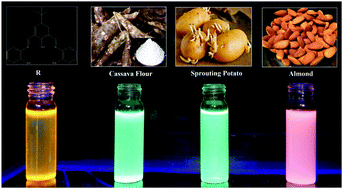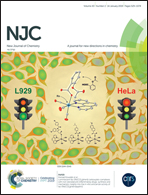An easy to make chemoreceptor for the selective ratiometric fluorescent detection of cyanide in aqueous solution and in food materials†
Abstract
A simple easy to make chemoreceptor (R) has been synthesized from commercially available starting materials by single step condensation at RT in good yield. The receptor has been characterized using 1H and 13C NMR and mass spectral techniques. R acts as an efficient ratiometric fluorescent probe for the selective detection of cyanide in aqueous solution (DMSO–H2O 20–80% v/v) with an instantaneous colour change from yellow-orange to green under a UV lamp in the 4–8 pH range. The detection of cyanide occurs via deprotonation of a phenolic –OH group by a cyanide ion as evidenced from a 1H NMR titration experiment. The probe interacts with cyanide in a 1 : 1 stoichiometric manner with a detection limit of 0.96 μM. The probe R is able to exhibit a similar fluorescence change with extracts of cyanide-containing food materials such as almond, cassava powder and potato. DFT computations well substantiate the results of spectral studies.



 Please wait while we load your content...
Please wait while we load your content...